Is the astonishing resemblance between the “Meiquan 22nd Century” in Chongqing and the Wangjing SOHO in Beijing merely a coincidence or are there unknown factors behind the scene? A microblog post put the two buildings in the spotlight.
Arguments: koi or cobblestones
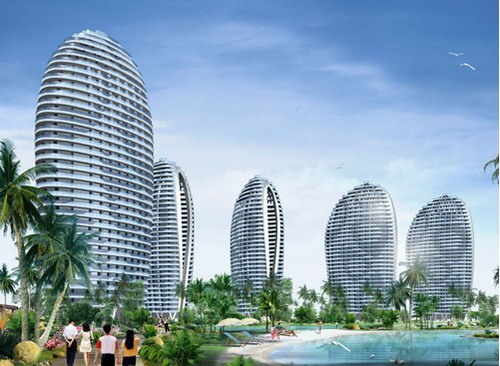 |
| Phoenix Island in Hainan province |
On May 10th, a Chongqing medium published an advertisement titled “Iconic Landmark in Chongqing—Meiquan 22nd Century.” Later the same day a message was posted on Sina Microblog, reading: “Even the orientations of the buildings resembled that of Wangjing SOHO, why wasn’t it named ‘Meiquan?Wangjing SOHO’ directly?” The advertisement and the post soon brought the talk of Meiquan 22nd Century to a boil. It wasn’t long before Zhang Xin, CEO of SOHO China, posted several messages accusing Chongqing Meiquan of copying the design of Wangjing SOHO. “From the appearance of the architectures to the designs of its official website and ads, Meiquan 22nd Century directly copycatted the Wangjing SOHO. It is rare to see such a complete plagiarism.” Later, Pan Shiyi, Board Chairman of SOHO China, posted messages to support his wife Zhang Xin, claiming that after communications with Zaha Hadid Architects, the company that designed the Wangjing SOHO, SOHO China had determined to uphold its rights and “bring the infringers to court.”
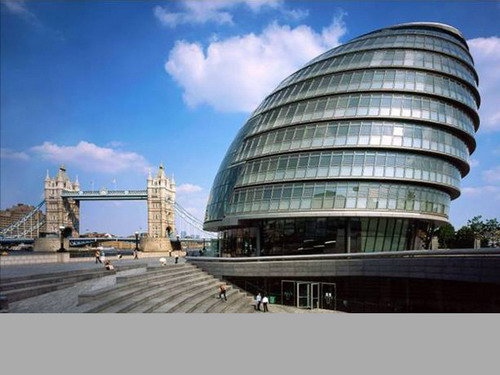 |
| London municipal building |
On May 11th, SOHO China officially announced that it had delivered a lawyer’s letter to Chongqing Meiquan stating that it believed that the presentation and construction of Meiquan 22nd Century had severely infringed upon the copyright of Wangjing SOHO.
On May 14th, SOHO China and Chongqing Meiquan held press conferences respectively. Chongqing Meiquan, speaking with Chongqing dialect, stated that the design of Meiquan 22nd Century was inspired by the cobblestones on the bank of the Yangtze River by which Chongqing was built. He demanded that SOHO China delete the “untruthful accusations on Sina Microblog and withdraw the lawyer’s letter.” However, Pan took a tough stance on this issue, saying that Wangjing SOHO was designed to reproduce the image of Koi, which symbolizes “wealth, luck, health and happiness” in Chinese culture, and insisted on filing a lawsuit.
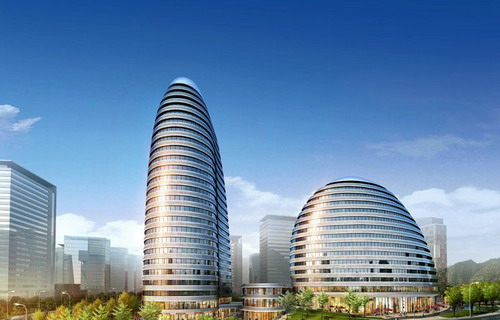 |
| Meiquan 22nd Century |
On May 15th, Pan published an article Wangjing SOHO Being Plagiarized to criticize Chongqing Meiquan, requiring the latter “give SOHO China justice,” otherwise, “thieves will become robbers who dare to commit crimes in broad daylight.” Pan emphasized that the design of Wangjing SOHO was rendered by Zaha Hadid Architects, which was a fruit of open tenders, design optimizations, and large amounts of efforts and hoped that their creative efforts and devotion could be respected. He also thought that in order to guarantee the healthy development of China’s creative industry, it was necessary to protect creative ideas and IP rights in China.
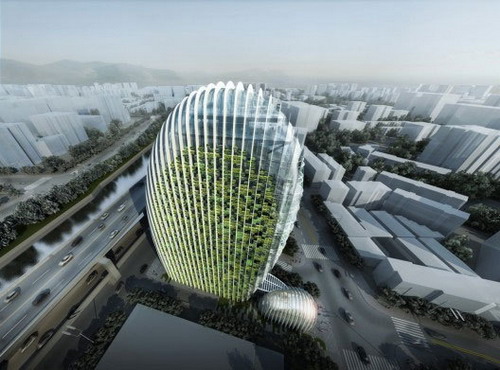 |
| Taibei high-tech building |
On May 16th, Meiquan 22nd Century posted a message through its official microblog: “Should one look down upon others only because he has invited a great designer? Can’t one see that the nature is the greatest master? Does SOHO own all Chinese land simply because it has a piece of land in Wangjing? Doesn’t it know that there is Chongqing?” It also launched a brand new advertisement slogan: “Never meant to copy, only want to surpass.”
Inspections: plagiarism or not?
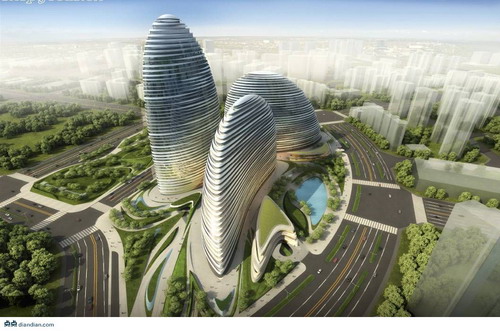 |
| Wangjing SOHO |
In the highly professional architectural industry, the design process of architecture is usually divided into four major stages: conceptual design, schematic design, preliminary design and constructional design. At the stages of conceptual design and schematic design, the designers will study some classic buildings or the competitors’ buildings, which can easily lead to references and imitations. The design sketch indeed shows certain similarities between Wangjing SOHO and Meiquan 22nd Century. However, Meiquan 22nd Century enumerated many buildings bearing similar appearances, such as the office building of China Life Insurance Company in Henan province, Phoenix Island in Hainan province, and China Mountain, etc. It is hard to determine whether imitations constitute copyright infringements.
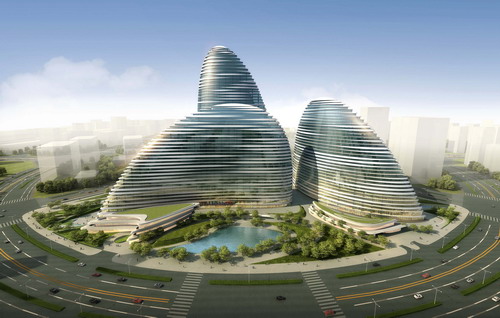 |
| Wangjing SOHO |
Chen Mingtao, an IP law professor in Beijing Jiaotong University, commented: “Usually, architectures are classified as works of applied art, which possess both functionalities and artistic qualities. Structures such as lobbies, windows and roofs have their specific functions respectively, and therefore can hardly be subjected to copyright protections because such protection will prevent others from adopting the same or similar structures, which will severely harm the public interests. However, it doesn’t mean that the artistic qualities of these structures could not be protected. These artistic qualities should be protected, for they reflect the unique design of the designer. At present, the functionalities and artistic qualities are often integrated with architectural designs and it is hard to separate them from one another, which should be considered in determining infringements. Under this circumstance, functionalities should not be denied entirely.
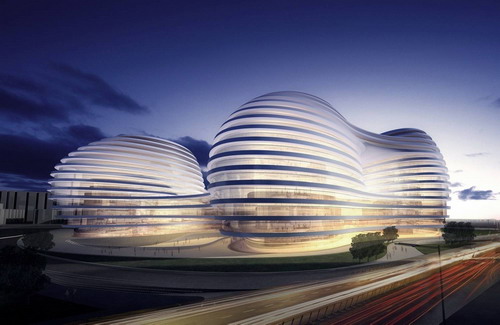 |
| Yinhe SOHO |
Although the unique features of architectures have posed many difficulties to the determination of infringement, it does not mean that there are no standards. “In terms of copyright infringements upon general works, the court usually applies the standard of “access + substantial similarity” in judicial practices, i.e. there are identical contents which exist in the obligee’s work and the alleged infringing work, and identical points or substantial similarities in the expression. Under this precondition, if it can be proven that the alleged infringer had access to the obligee’s work, then the disputed work could be deemed as derived from the obligee’s work and was not created independently.
Similarly, the same standard should be applied to architectural designs while fully considering the distinguishing characteristics of architectures. Firstly, unnecessary functionalities should be eliminated from professional perspective in order to select and pick out elements which carry the artistic qualities. Secondly, the obligee’s architecture should be compare with the alleged infringing work so as to find identical or similar features, and determine whether it constitutes substantial similarity as a whole from the stand-point of the public. That is to say, both features of specific parts and similarity as a whole should be considered, both professional and public opinions should be valued. Of course, during the whole determination process, other factors may also be taken into consideration, such as whether the alleged infringer had access the obligee’s work, the working environment, motivations and aims of the alleged infringer, etc.,” explained Chen Mingtao.
In China, there have already been judicial cases to confirm the aforesaid theories. Zhao Junjie, Lawyer at Trust Law Firm said that: “There are sample cases for research in China’s judicial practices. For example, in Porsche AG v. Beijing TechArt Automotive Sales & Service Co., Ltd., a case over copyright and related rights (final judgment of the Beijing Higher People’s Court (2008), civil judgment No. 325). It is a typical case which was listed in the Top 10 IP Cases of 2008 released by the China’s Supreme People’s Court. At trial, the main focuses of the controversy were (1) whether or not architectures are “works” protected by China’s Copyright Law, (2) the determination of the exclusive copyright owner of the architecture, and (3) whether the defendant had infringed upon the plaintiff’s right and bore corresponding liabilities. Through this case, the court made it clear that architectures are objects of copyright protection, and imitated constructions should be deemed as copyright infringements. In addition, the judge also took full account of the distinctiveness of architectures by merely ordering a reconstruction rather than a demolition to save social resources and eliminate impacts on city planning.”
It can be seen from this case that, on the one hand, the court comprehensively analyzed the features of the plaintiff’s architecture, confirmed that it should be deemed as a “work” for its unique appearance, beauty and originality; on the other hand, it also excluded certain features from the protection of the Copyright Law, such as the inside structure, necessary designs and the grains and colors generated by the building materials. To some extent the defendant’s building, the “TechArt Center,” differed from the plaintiff’s building, the “Porsche Center,” in subtle details, such as the location of the high platforms, railings, exhibition halls and work cells, the partially arched appearance and the shade of the whole architecture. However, the basic features were too much of a resemblance and would remind the general public of the latter. Therefore, it was still similar to the plaintiff’s work and constituted copyright infringement.
At present, Wangjing SOHO and Chongqing Meiquan have entered judicial proceedings. The staff of SOHO China told China IP that they were now “working hard on this case.” Whether the similarities are a pure coincidence or not shall be determined by the court.
Reflections: legal provisions
As an influential person in China, Pan Shiyi’s involvement raised the public’s attention to the long standing but still unsolved problem of “architecture piracy” in no time. In fact, in recent years courts have addressed many similar cases in the architectural industry, e.g. the aforesaid Porsche AG v. Beijing TechArt Automotive Sales & Service Co., Ltd. case and the Huizhou Hallstat case, etc.
Up to now, there is no special law in China which has specific provisions on IP rights related to architecture. “According to the stipulation of Article 4 (9) of the Implementing Regulations of the Copyright Law of the People’s Republic of China, ‘architectural works are works which in architectural building or expressed in similar format, when being viewed, impart aesthetic effect.’ According to the definition, the present law holds that architectural works only include buildings and formats of three dimensional expressions, while excluding other forms, such as design drawings and models. However, this doesn’t mean that design drawings and models could not be protected by the Copyright Law. Design drawings can be protected as engineering designs while models as works of art. That is to say, the copyrights of the design drawing, the model and the substantial entity are protected separately,” said Chen Mingdao.
Lawyer Zhao Junjie offered his advice on this issue as well: “Different protective measures could be applied according to the specific features of the design drawings, the models and the architectures, e.g. asking all parties involved in the design to sign a confidentiality agreement, improving the storage management system of the design drawings and models, and taking measures to protect IP in various exhibitions.”
In terms of regulating the architecture market and fully protecting IP rights, Chen Mingtao commented: “At present, the Chinese provisions on architectural works are too vague, there is a lack of detailed regulations on the content and symbolic meanings of architectures, the protection of public welfare constructions and the influences of functional elements on originalities, etc. Therefore, relative stipulations should be made through amendments to the law and legislation written based on the specific features of architectural works.”
Lawyer Zhao Junjie put forward “two explorations and one difficulty” on this issue, holding that the law needs further exploration to (1) find out the most reasonable way to protect architecture: Should it be protected as a whole or should we protect each part separately and (2) decide if it is necessary to determine the “originality” of architectures and if so how should we define it. He also pointed out that special attention should be paid to infringing liabilities. It is hard to take action against infringing architecture and the issue and range of remedies must be addressed.
(Translated by Monica Zhang)







